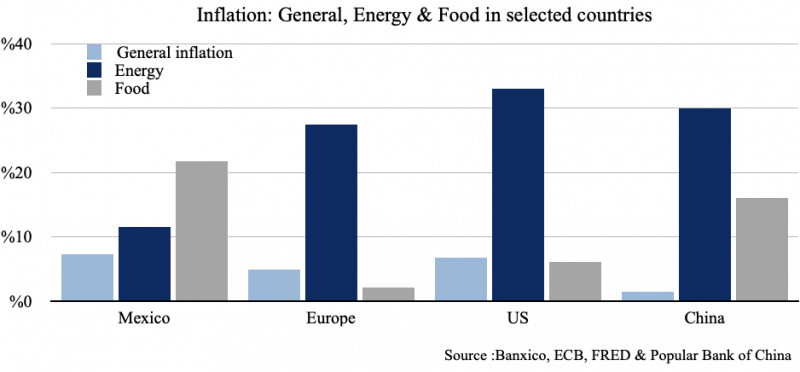The most expensive christmas of the century (so far)
- blog de anegrete
- 2065 lecturas
Globally, inflation closed 2021 with its highest level in the last twenty years (40 years in the case of the US) and projections indicate that during 2022. However, even if lower than last year, it will remain high in 2022. Why is it one of the main concerns of governments, central banks and consumers?
Governments are concerned that central banks may accelerate interest rate normalisation in the face of high inflation rates. It would slow down economic recovery and job creation and, in some cases, lead to deteriorating fiscal balances in some countries that acquired debt to mitigate the effects of the economic contraction or slowdown. This is particularly so in G7 countries that have over 100% debt on GDP, but also in emerging economies and in lower-income economies, with less debt ratios but meagre incomes.

Central banks changed the discourse in which they considered inflation as transitory and now established the existence of excess demand. Supply chains are gradually re-establishing themselves and relieving any pressures on production. This extra demand now explains inflation, and consequently, central banks changed their action plan from keeping rates close to zero to raising them. Since von Mises (1912) established the idea that inflation was the first enemy of the people, and the result of printing money to cover fiscal expenditures, (Ch.2, S.8 and Ch. 7, S.3) the object of monetary policy has been to keep inflation very low. When it has failed to do so, the effects felt were an impoverishment of the population and later political demand for change. (Germany, 1923; Hungary, 1945; Bolivia, 1984; Brazil, 1989-1990; Peru 1989-1992; Argentina 1989-1990; Yugoslavia, 1992). Inflation in many countries in 2021 results not from massive deficits save the US the UK but from external factors. Some Latin American countries borrowed to reactivate the economy but in smaller proportions than the massive G7 fiscal deficits. No country aside from the US had a massive expansionary fiscal policy equal to at least 15% of its national GDP. No country in Latin America held a 6% fiscal deficit on GDP. Yet, inflation arrived. The paradox is that the FED and the BoE have decided to keep inflation high because of the social and international costs of reducing it. Is this a new beginning?
The normalisation of monetary policy will limit inflation in products with excess demand and reduce liquidity in financial markets. It wants to minimise speculation in commodity and futures markets which could eventually reduce consumer prices and revenues of commodity-exporting countries.
This approach, however, only looks at part of the problem. The increase in prices of a consumption basket of certain goods defines inflation. It does not include all common consumer goods; it excludes some food and energy. Monetary policy has a minimal influence on these given their exogenous origins, such as drought or seasonality and a military standoff in Ukraine. Food and energy price rises reduce consumers' purchasing power and are now more significant than those considered in the average inflation basket. For example, in Mexico, the increase in fruits and vegetables was 21 %, while the rise in the consumer price index was 7.36%. Wages will rise less than 4%.
Engel's law works. There is an inverse relationship between income level and food expenditure. Not all consumers participate in the same way and the same proportion. The lower the income, the more significant the proportion spent on food and essential services, which have risen in price more than durable goods, thus resulting in greater poverty. The sharp contraction in GDP in 2020 has produced more poor people and cut incomes through inflation, forcing changes in consumption patterns.
Monetary authorities are again faced with the trilemma of controlling inflation, keeping stock and commodity markets at their current dynamics, or allowing economic growth. Monetary policy instruments to control inflation are somewhat limited; that is why the FED and the Bank of England consider allowing inflation in 2022 to remain above their traditional targets (2 %).

In China, the situation is similar, with substantial increases in energy and vegetable prices. The biggest concern for the world is that country's producer price index because China is where many of the supply chains start. Thus, producer inflation can be passed on to much of the world's goods and services and further inflame the existing price hikes.
If wage increases in 2021 do not offset price increases, it will affect workers' real income and quality of life. It will then be necessary to use alternative mechanisms to lower prices, such as US oil reserves or the sale of China's mineral and food stockpiles.
In conclusion, inflation will be a relevant variable in 2022 due to its effects on monetary policy, economic growth, and the dynamics of financial markets. The strategies followed by governments and central banks to control inflation will determine the economic conditions for the following years and the world's ability to recover from the economic contraction of 2020.